

Google Glasses Design Patents and Other Wearables. Google was granted three different design patents for augmented reality glasses today, showing slightly different looks from one to the other.
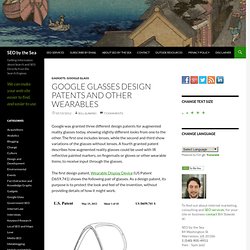
The first one includes lenses, while the second and third show variations of the glasses without lenses. A fourth granted patent describes how augmented reality glasses could be used with IR reflective painted markers, on fingernails or gloves or other wearable items, to receive input through the glasses. The first design patent, Wearable Display Device (US Patent D659,741) shows the following pair of glasses. As a design patent, its purpose is to protect the look and feel of the invention, without providing details of how it might work.
Last month I wrote about an acquisition of a few glasses patents by Google from Motion Research Technologies, Inc., that provide some hints at how such technology might work. The second design patent, Wearable display device frame (US Patent D659,740) shows a variation of the glasses without lenses. Google’s Project Glass Not As Full-On As Preview Suggested. It seems that Google's augmented reality specs, codenamed Project Glass and revealed early last month, won't be quite as full-on as the initial promotional video indicated.
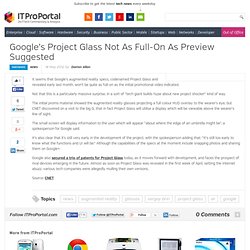
Not that this is a particularly massive surprise, in a sort of "tech giant builds hype about new project shocker" kind of way. The initial promo material showed the augmented reality glasses projecting a full colour HUD overlay to the wearer's eye, but CNET discovered on a visit to the big G, that in fact Project Glass will utilise a display which will be viewable above the wearer's line of sight. The small screen will display information to the user which will appear "about where the edge of an umbrella might be", a spokesperson for Google said. Augmented Environments Lab. Mos.futurenet.com/pdf/computerarts/CAP125_tut_augreal.pdf. Augmented Environments Lab » Projects. Medical app uses augmented reality and camera phone to detect skin cancer. Here at iMedicalApps, we are especially interested in any developments in the mobile world which we can utilize as physicians to provide better healthcare and better outcomes for our patients.
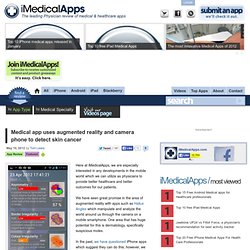
We have seen great promise in the area of augmented reality with apps such as Hallux Angles which manipulate and analyze the world around us through the camera on a mobile smartphone. One area that has huge potential for this is dermatology, specifically suspicious moles. In the past, we have questioned iPhone apps which suggest they can do this; however, we do recognize that this technology has a fundamental role to play in future years. DoctorMole is a free Android app that uses augmented reality to analyze suspicious moles using the standard ABCDE approach in order to determine risk.
While we and the app’s developers recognize this is absolutely and equivocally no substitute for qualified professional advice, we are intrigued by the innovation and promise this app holds. Price: Seven awesome augmented reality campaigns. Augmented reality ads are slowly making their way into the mainstream, with more and more brands using the technology to engage consumers with hidden digital content.
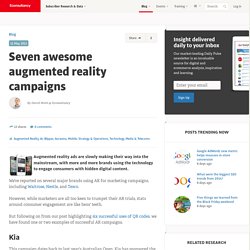
We’ve reported on several major brands using AR for marketing campaigns, including Waitrose, Nestle, and Tesco. However, while marketers are all too keen to trumpet their AR trials, stats around consumer engagement are like hens' teeth. But following on from our post highlighting six successful uses of QR codes, we have found one or two examples of successful AR campaigns. Kia This campaign dates back to last year’s Australian Open. During the matches viewers were encouraged to download Kia’s bespoke AR app that linked them to digital content about the Aussie Open and the Kia Optima. The AR app recorded 12,630 downloads and there was an increase in Optima searches of 58%. As a result, Kia said that it achieved 57% more sales than expected of the new Optima in January. Augmented Reality Placemats Announce Upcoming Events.
Marketing And Augmented Reality: The Real Deal? Absolut Inspire: Augmented Reality Street Art Check out this Future Lions 2012 entry by Iris Gavric & Daniel Otterbein… Proposed for Absolut Vodka, they’ve attempted to create movement called Absolut Inspire, an Augmented Reality Street Art App designed to create a new world without creative limitations.

The campaign is a fusion of the Google Street View platform combined with an app that allows you to create your own digital street art anywhere in the world, all seen through the augmented reality viewer. Sure, there are a bunch of concepts out there like this, but the integration with the brand and bottle is great, and I’m really glad the next generation of creatives are already digital… Be Sociable, Share! Absolut Inspire, Absolut Inspire Augmented Reality, Absolut Inspire Augmented Reality Street Art, Absolut Vodka, Augmented Reality, Google Street Art, Google Street View, Google Street View Apps, iPhone Apps.
Into the Matrix: the future of augmented reality (and you) The growth of augmented reality (AR) will almost certainly change the way we visually experience the everyday world.
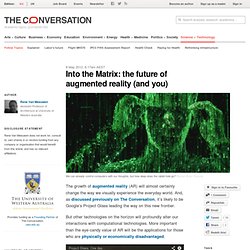
And, as discussed previously on The Conversation, it’s likely to be Google’s Project Glass leading the way on this new frontier. Metaio Creator: Augmented Reality Software for Non-Developers. The metaio Creator is a new software that will enable non-developers to create and deploy Augmented Reality experiences with no coding necessary.

The application is the next step in Augmented Reality content production, and was specifically designed for non-developers, designers and people who have the desire to create amazing AR experience but wish to do so without using a hard-coding environment. The metaio Creator is compatible with junaio and can be used to quickly deploy custom, cloud-based AR content to Android and iOS devices. Developers and Creator users alike will benefit from an upcoming junaio update that will allow for HTML and JavaScript interactions and dramatically increase the possibilities for mobile experiences. News - MirageTable: Microsoft presents augmented reality device. 9 May 2012Last updated at 07:57 ET Researchers used the device to collaborate on how to build an object out of blocks Microsoft has shown off an augmented reality system that allows users at different locations to work together on tabletop activities, sharing objects which they can both handle.

The MirageTable was demonstrated at a conference in Austin, Texas and is outlined on the firm's research site. Nokia's City Lens Brings Augmented Reality to Windows Phone. By Shawn Ingram | Nokia’s newest exclusive Windows Phone app is City Lens, an augmented reality app that looks like it could replace Local Scout for Lumia owners.
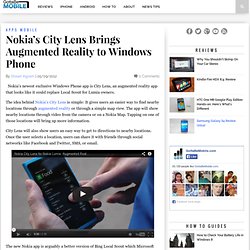
The idea behind Nokia’s City Lens is simple: It gives users an easier way to find nearby locations through augmented reality or through a simple map view. The app will show nearby locations through video from the camera or on a Nokia Map. Tapping on one of those locations will bring up more information. City Lens will also show users an easy way to get to directions to nearby locations. The new Nokia app is arguably a better version of Bing Local Scout which Microsoft builds into Windows Phone. Pioneer intros car head units with augmented reality screen. Pioneer GPS head units due in July for nearly $4,000 Pioneer introduced two new Cyber Navi head units for vehicles that can display augmented reality (AR) information in front of the driver, Tech-On reported.
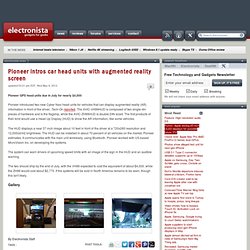
The AVIC-VH99HUD is composed of two single-din pieces of hardware and is the flagship, while the AVIC-ZH99HUD is double-DIN sized. The first products of their kind would use a Head Up Display (HUD) to show the AR information, like some vehicles. The HUD displays a near 37-inch image about 10 feet in front of the driver at a 720x260 resolution and 12,000cd/m2 brightness. The HUD can be installed in about 70 percent of all vehicles on the market, Pioneer estimates.
Pioneer touts world's first car GPS with augmented reality HUD (video) LuminAR. Microsoft Applies for Patent on Augmented Reality, 3-D Audio. Microsoft's 3D audio patent application could add new features to the Kinect. Photo: USPTO Surround-sound systems are great for playing games and watching movies when you’re in the “sweet spot” of focused audio. When you’re sitting off-center, however, the audio sounds less like all-enveloping 3-D surround sound, and more like a garbled aural mess. But now it looks like Microsoft may have a solution. Innovega Inc. - HOME. My wallet is open, Google, now hand over Project Glass. Project Glass has opened my eyes and my wallet: Google, please, come help yourself to my credit card. The much-rumored wearable augmented reality system has emerged from the Google[x] skunkworks and it's even more than we hoped for. No clunky headset like a bad pair of swollen sunglasses, but a sleek slice of transparent display with just enough Star Trek: TNG hints to keep the geeks happy.
With a concept video and a handful of rumors, though, there are still plenty of questions remaining. Google hasn't talked technology regarding Project Glass, focusing instead on the potential user experience, but there's enough here to slot together a few suggestions. The eyepiece itself is a pretty specialist part: it takes some serious know-how to produce a transparent display that can float computer graphics on top of a real-world view without causing headaches or skewing problems. Still, if it's the OE-31, then that means nHD 640 x 360 resolution.
Google testing heads-up display glasses in public, won't make you look like Robocop.